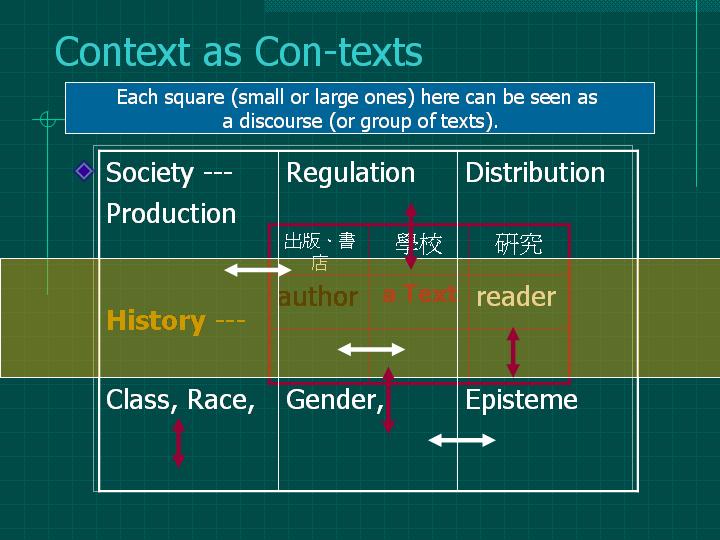![]()
Part II: Essay Questions
I. History, New Historicism,
Postcolonialism and Identity
![]()
|
1. Historical Methods: choose two of the following texts and compare and contrast the historical methods they use to present or refer, directly or indirectly, to a historical event (or some historical events) and the messages/ideologies they convey through the event(s). (For your reference, the various historical methods we've discussed are: the process of selection, synthesis and representation; with representation, you can choose to consider emplotment, embodiment [with dramatization or in characters, etc.], the use/exposure of narrative frames, narrative perspective [e.g. multiple, partial or totalizing], and the establishment of credibility. Also, there is a difference in history shown as a 'time travel' and history as 'costume drama.') (Possible texts: "Rip Van Winkle," Forrest Gump, 《暗戀桃花源》; 《悲情城市》,《香港有個荷里活》, Stuntman, In Country, Hiroshima mon amour, 11"09"01 --September 11). 2. Racism and
its Consequences/Resistance: How is colonialism and racial discrimination
justified by discourses of racism and racial stereotypes? Use two of
the following texts to discuss examples of racism and racial stereotypes
and their influences--then give some examples of the racism happening
in our society. (Please pay special attention to subtler forms of racism
such as assimilation, containment, internal racism. In discussing the
effects, the various forms of racial identities--e.g. assimilationist,
separatist, active participation in and/or joining of the two cultures,
the subaltern vs. the intellectual in-betweener--can be considered.)
|
II.
Postmodernism,
Globalization and Trauma
![]()
|
1. National Identity, Colonialism and Globalization: How is the national identity of both the colonial and colonized nations challenged, if not deconstructed, by colonialism on the one hand, and the global flows (of people, capital, commodities, catastrophes and political conflicts) on the other? How should we look at national identity --both on the individual and collective levels--in this age of globalization? Theoretically, please consider the national identities of one colonial nation and one colonized nation. Then use two texts to talk specifically how signs of nation get modified or challenged by the forces from other cultures or other nations. (You can use either 《悲情城市》,《香港有個荷里活》, In Country, 11"09"01 --September 11 or texts of your own choice.) 2. Depthlessness and Aesthetic Self-Reflexivity: In this postmodern society of overall commodification, disorganized capitalism and telecommunication, signs are produced, exchanged and consumed at an ever-accelerating speed. These "economies of signs" can make cultural texts meaningless patische or self-reflexive parody, make readers flattened and blase (indifferent) consumers or conscious bricoleurs(developing their styles with the bits and pieces they collect). Also, they can make (media and Internet) communication frequent, intimate, or obscene, turning even a historical trauma into a spectacle for consumption. Please elaborate on these possiblities--remember to include both the positive and negative aspects--and give at least two examples of your own choice to illustrate your points. (If you don't have any examples at hand, you can use the sequence of 龍的傳人, and/or Forrest Gump as examples.) 3. Hybridity(雜種、雜多): Of the concepts discussed in our class, hybridity is probably the one term most rich with diverse meanings. It can be a consequence of colonial mimicry, immigration, as well as postmodern global interchanges of signs and cultures. In 《悲情城市》and《香港有個荷里活》we see the hybrid signs of language and national flag, while at the same time some signs (such as Hollywood and 祖國) get emptied out, and some others get translated (e.g. 〈流亡三部曲〉and Journey to the West). We can also see people of hybrid identities in some of the texts we read(e.g. "The Management of Grief," Bamboozled, etc.) as well as in the texts and people around us. Do these hybrid signs deny or allow constructions of identity? In other words, is hybridity empowering, disrupting or disintegrating our sense of identities? 4. Stories of Trauma: Two interrelated issues of trauma that we have discussed are: its survival and representability (understandility). How do the the texts we have read deal with them (or one of them)? Choose two. (Possible texts: 《暗戀桃花源》; Stuntman, In Country,Hiroshima mon amour, "Summer Flower," "Human Ashes," "Recollection," "The Management of Grief" and 11"09"01 --September 11.) |
II.
Literary
Criticism and Cognitive Mapping
![]()
|
1. Multiple Perspectives: Except for New Criticism, the many theoretical schools we are engaged in, and definitely the topics of globalization and trauma, do not really give us methodologies; rather they provide us different framework to place a literary text in, or different perspectives (or lenses) from which we can examine a text. Choose a text we have discussed in class and examine it from two or more perspectives. 2. Why is "context" an important thing to consider in analyzing a text? What does it mean for New Historicists to see context as "con-text" and for Foucault to see author not as the creator of a group of texts, but as a label on them? Please also compare the following two charts in their different ways of placing a text, and then use one text (of your own choice) to discuss its relations with its context(s). (Please note that 'context' can also be that of the readers.)
3. Cognitive Mapping: F. Jameson argues that postmodern hyperspace (such as a mega shopping mall or the Internet space) makes cognitive mapping (a process by which the individual subject situates himself within a vaster, unrepresentable totality) impossible. Without getting into the details of his argument, we may say that the postmodern compression of time and space (or acceleration of production, communication, information transmission, ..., everything) does make cognitive mapping hard, if not impossible. What do you think about the use of CMap tool to help? Here are some maps we have made in class; you can use any one of them as your example.
|
||||||||||||||||||||

